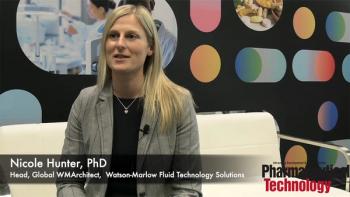Editor’s Note:This article was published in Pharmaceutical Technology Europe’s September 2020 print issue.
- Pharmaceutical Technology-09-02-2020
- Volume 44
- Issue 9
Determining Water Content with a Novel Karl Fischer Titration Approach
A new approach to testing water content in biologics is needed that will give a more accurate determination of actual water content in the biologic.
When developing and validating new water content determination methods for pharmaceutical materials, the need for an oven extraction is often necessary when the material has dissolution issues during titration (1). During these validations, it is common to spike sample material with standards in order to obtain a linearity curve for the method. Current commercially available solid standards are certified for analysis to a minimum temperature of 140 °C, which is acceptable for most materials (2); however, biologic materials often degrade at temperatures below the current commercial standards (2). This study evaluated the application of glucose monohydrate (GlcH) as a standard. The thermal properties of GlcH (3) make it an excellent candidate because it is a saccharide, which is a common cryoprotectant for biological materials (4–6), and thus should be compatible with a multitude of samples. GlcH was not spiked into sample material and, instead, was analyzed as received. This was done because of limited access to sample material.
Material and methods
Materials
GlcH was sourced from a bulk supplier with a water content value of 9.0% per the accompanying certificate of analysis (CoA). All calculations of percent recovery for the bulk GlcH material were calculated from the CoA value. All preparations of GlcH were performed under ambient laboratory conditions. Bulk sample material for GlcH was stored in a desiccator when not in use to minimize moisture adsorption over time. Glucose in the absence of a hydrate will be identified as Glc.
Instrumentation
•KF headspace oven—a KF headspace oven was used that had an operating temperature range of 50 °C to 250 °C and a 32-vial autosampler.
•Thermogravimetric analyzer (TGA)—a commercial TGA was used for analysis with an operating temperature up to 1000 °C with a maximum heating rate of 50 °C/min.
Methodology
Initial evaluation of the thermal properties of GlcH was performed through use of a temperature gradient using the KF headspace oven. For this analysis, the temperature was ramped from 50 °C to 150 °C at a rate of 1 °C/minute with a nitrogen flow rate of 50 mL/minute. The upper temperature limit of 150 °C was chosen since the GlcH was expected to degrade at this point by undergoing a Maillard reaction, which would create excess water (7). The results from the temperature gradient, shown in Figure 1, demonstrate the drift and the micrograms of water measured towards the asymptote to approach a slope of zero just below the temperature of 70 °C. This matches the expected value from literature and is believed to be the temperature at which the hydrogen bond between glucose and the water of hydration breaks, which releases water from the GlcH (8).
The GlcH was analyzed using the KF headspace oven at varied temperatures, as outlined in Table I, and the percent water measured was evaluated against the certificate of analysis value of 9.0% water as the percent recovery. The percent recovery results from Table I suggest GlcH does not release water as readily as the temperature gradient analysis in Figure 1 indicates.
Further evaluation of the GlcH was performed using thermogravimetric analysis (TGA) to determine the rate at which water is released. The GlcH was analyzed at two different temperature ramp rates, 1 °C/min and 10 °C/min, to evaluate the differences between the sample slowly coming to temperature and the sample rapidly coming to temperature (i.e., the sample being analyzed is inserted in a preheated oven) (9). The thermograms, as shown in Figure 2, show the rate at which GlcH is heated can greatly affect the behaviour of the material and how the moisture is released. One potential and critical explanation for this difference is that GlcH undergoes a phase transition at 83 °C that causes the structure to re-arrange, which entraps the bound water within the material. The phase transition of GlcH has been extensively evaluated (3) and explains the various mechanisms that caused the differences in the release of water. As shown in Figure 1 and Figure 2, both analyses took place under nitrogen flow and were uniformly heated at a rate of 1 °C/min, and GlcH appears to effloresce just below 70 °C. In order to increase the heating rate of GlcH to be more uniform, the particle–particle interaction and, in turn, the packing coefficient, would need to be increased to optimize the heat transfer (10). An aliquot portion of the GlcH was put through a ball mill for five minutes to reduce the particle size in order to better optimize the packing coefficient and subsequent heat transfer of the material.The quantitative reduction in particle size was not evaluated; however, increased duration in milling time would likely further decrease the average particle size, thus increasing the packing coefficient (11). The ball-milled GlcH was then analyzed on the TGA at a ramp rate of 10 °C/min. Figure 3 shows the thermogram from the ball-milled GlcH overlaid with the thermogram from the 1 °C/min-ramp-rate analysis of bulk GlcH.
The thermograms from the ball-milled GlcH more closely matched the thermogram of the 1 °C/min-ramp-rate analysis, which suggests the reduced particle size provided a more uniform heating process even when heated at a faster rate. The milled GlcH was then analyzed using the KF headspace oven at varied temperatures to evaluate measurement stability. Due to the heat generated from milling, the certificate of analysis of the GlcH value for water content was no longer applicable, and the aliquots were analyzed at 130 °C for a prepared batch to determine the water content of the milled GlcH. The milled GlcH results shown in Table II were evaluated against the average values obtained at 130°C to determine the percent recovery. During sample preparation it was noted the GlcH was difficult to handle because milling the material caused it to become statically charged. Weighing a specific sample size and ensuring proper sampling was difficult since the GlcH stuck to the sampling utensils and the walls of the glass vial in which it was stored. To alleviate this, the flow aid, lauric acid, was added to minimize the sticking of the milled GlcH to various surfaces (3) (10). Lauric acid was added in various concentrations to evaluate its impact on the measurement consistency of GlcH water content analysis and the results are reported in Table II as well as the prepared concentrations.
Conclusion
GlcH is an acceptable standard for use in water content determination using a KF headspace oven at temperatures below 100 °C. This would bridge a gap since there are no current standards available for use at temperatures below 140 °C and would allow extension of KF headspace oven analysis to materials that release water at or below 100 °C. The reduction in particle size was a key factor in ensuring consistent measurements and will likely need further evaluation to determine the ideal grain size for ideal testing parameters. The use of a flow aid such as lauric acid is recommended to ensure sampling, and preparation of the material should be consistent to improve sample precision. The use of alternative flow aids may be applicable but would need further evaluation.
References
1. J. Ahn and J. Jung, Applied Sciences 7 (7)(2017).
2. S. Zulaikah et al., AIP Conference Proceedings 1617 (1) (2014).
3. S.S. Bharate, S.B. Bharate, and A.N. Bajaj, Journal of Excipients and Food Chemicals 1 (3) 3-26 (2010).
4. L.A. Bulavin, et al., Ukrainian Journal of Physics 62 (6) (2017).
5. C. J. Capicciotti et al., ACS Omega 1 (4) 656-662 (2016).
6. D. Lechuga, D. Miller, and S. Duddu., Lyophilization of Biopharmaceuticals 3-41 (2004).
7. EMD Millipore, “Recommended AQUASTAR Water Standards for Karl Fischer Titration.” n.d.
8. H. Belitz, W. Grosch, P. Schieberle, Springer, 263-282 (2009).
9. W. H, Hsieh et al., Journal of Biomedical and Pharmaceutical Sciences 1 (1) (2018).
10. J. Li and Y. Wu, Lubricants 2 (1) 21-43 (2014).
11. Mettler Toledo, “Good Titration Practices in Karl Fischer Titration.” n.d. 70-72.
12. N. Okubo, TA Application Brief 63 (1993).
13. P. Steponkus, D. Lineberger, Plant Physiol 65 (2) 298–304 (1980).
14. R. Rowe, P. Sheskey, and M. Quinn, Handbook of Pharmaceutical Excipients 6th Edition (2009).
About the Authors
Gregory Maj is a senior scientist; Eric Olson is a senior research scientist; Jonathon Salsbury is associate director; Juan Vargas is a research scientist, all at PPD Laboratories; and Joshua Sherfinski is an undergraduate student at the University of Wisconsin Whitewater.
Article Details
Pharmaceutical Technology Europe
Vol. 32, No. 9
September 2020
Pages: 40-43
Citation
When referring to this article, please cite it as G. Maj, E. Olson, J. Salsbury, J. Vargas, and J. Sherfinski, “Determining Water Content with a Novel Karl Fischer Titration Approach,” Pharmaceutical Technology Europe 32 (9) 2020.
Articles in this issue
over 4 years ago
Moving Forward in Serializationover 5 years ago
Preparing Pandemic Vaccine Capacityover 5 years ago
Tracking API Quality During a Pandemicover 5 years ago
Capsule Innovations: Speeding Up Drug Developmentover 5 years ago
Manufacturing Drug–Device Combination Productsover 5 years ago
Advancing Understanding of a Traditional Techniqueover 5 years ago
Pharmacopoeia Compliance: A Practical Guideover 5 years ago
Streamlining Method Transfer Across Global SitesNewsletter
Get the essential updates shaping the future of pharma manufacturing and compliance—subscribe today to Pharmaceutical Technology and never miss a breakthrough.





